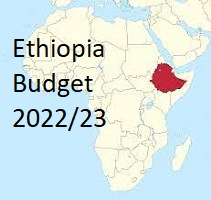Ethiopia’s 2022-23 Budget Review
This report reviewed the recently approved Government Budget for the 2022-23 fiscal year and summarize below some of its most notable elements.
1. Major Figures: The Ethiopian Parliament approved yesterday a government budget with planned expenditure of Birr 787bn (11% of GDP) for the new 2022-23 fiscal year, to be funded by Birr 439bn of revenue collections, Birr 39bn of grants, Birr 43bn of foreign borrowing, and Birr 266bn of domestic borrowing.
2. New Taxes: Budget measures being initiated include a widening of the VAT/excise tax base, new fuel excises, a new property tax, and some tax administration efforts.
3. Revenue is forecast to grow by 37% (14% in real terms), with the largest collections coming from income taxes (Birr 125bn, 28% of total), VAT on imports (Birr 64bn, 15%), customs duties (Birr 62bn, 14%), and VAT on services (Birr 45bn, 10%).
4. Expenditure is rising by 22% vs last year’s outturns, with large increases planned for transfers / subsidies (up 9.6x), defense (up 3.8x), and debt service (up 2.8x).
5. Wages are set to rise to Birr 76bn or by 46% (due to new hires plus higher salaries), but will be equivalent to 1% of GDP and thus still at the low end of global norms.
6. Capital expenditure by government will drop to just 3% of GDP, the lowest in a decade, and implying higher state enterprise and private sector capital outlays will be needed if investment-to-GDP ratios are to stay at current levels (28% of GDP).
7. Spending Quality: While poverty-reducing spending is near 60% of the overall budget, the sharply increased allocation for defense and debt service dues (at the expense of social spending and growth-promoting capital expenditure) points to a deterioration in expenditure quality. Whether this is a trend break from longstanding norms or a one-off exception remains to be seen in the coming years.
8. External financing: Only $706mn of foreign budget grants and $776mn of foreign budget loans are expected, roughly 81% and 53% of their past five-year averages.
9. Domestic financing: Besides the Birr 266bn in planned domestic borrowing, Government will need to rollover a large volume of T-Bills falling due this year (Birr 23bn per month, Birr 279bn in total). With such high demands on local debt markets, T-Bill rates will likely trend higher towards 10% or the low teens this year.
10. Domestic Debt: Due to Government’s heavy reliance on local borrowing, more than half of public debt is now owed to domestic lenders for the first time in years; this shift is reducing credit growth to the private sector, but improving medium-term.
DOWNLOAD THE FULL REPORT HERE: Ethiopia’s 2022-23 Budget Review
